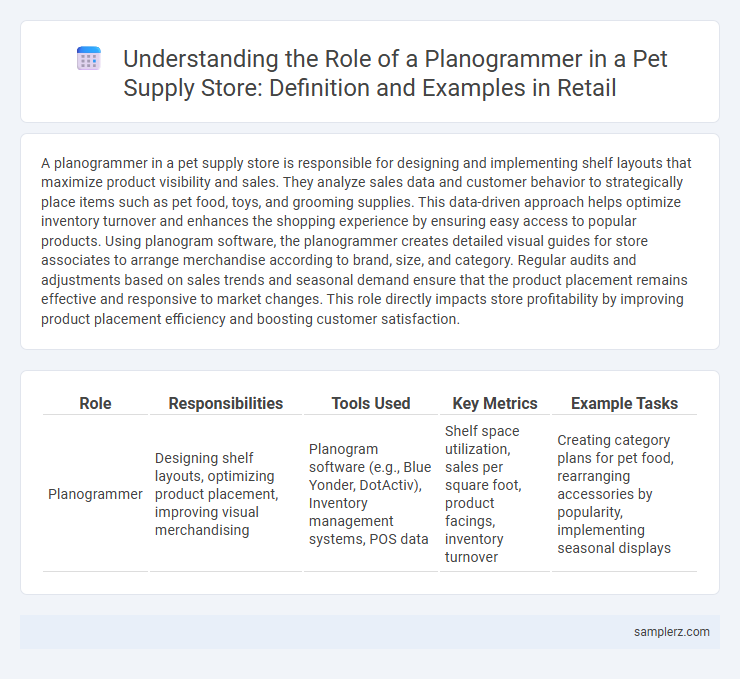A planogrammer in a pet supply store is responsible for designing and implementing shelf layouts that maximize product visibility and sales. They analyze sales data and customer behavior to strategically place items such as pet food, toys, and grooming supplies. This data-driven approach helps optimize inventory turnover and enhances the shopping experience by ensuring easy access to popular products. Using planogram software, the planogrammer creates detailed visual guides for store associates to arrange merchandise according to brand, size, and category. Regular audits and adjustments based on sales trends and seasonal demand ensure that the product placement remains effective and responsive to market changes. This role directly impacts store profitability by improving product placement efficiency and boosting customer satisfaction.
Table of Comparison
| Role | Responsibilities | Tools Used | Key Metrics | Example Tasks |
|---|---|---|---|---|
| Planogrammer | Designing shelf layouts, optimizing product placement, improving visual merchandising | Planogram software (e.g., Blue Yonder, DotActiv), Inventory management systems, POS data | Shelf space utilization, sales per square foot, product facings, inventory turnover | Creating category plans for pet food, rearranging accessories by popularity, implementing seasonal displays |
Introduction to Planogramming in Pet Supply Stores
Planogramming in pet supply stores involves strategically organizing products like pet food, toys, and grooming supplies to maximize shelf space and enhance customer experience. Effective planogrammers use sales data and consumer behavior insights to determine product placement, ensuring high-demand items are easily accessible and complementary products are grouped together. This approach increases sales, reduces inventory costs, and supports brand visibility for major pet supply manufacturers such as Purina and PetSafe.
Importance of Effective Planograms for Pet Retail
Effective planograms in pet supply stores maximize shelf space utilization, ensuring popular products like pet food, toys, and grooming items are prominently displayed to boost sales. Strategic placement guided by consumer behavior data enhances product visibility and accessibility, directly influencing purchasing decisions and inventory turnover. Implementing well-designed planograms supports brand consistency across multiple locations, improving customer experience and operational efficiency in pet retail.
Types of Planogram Strategies for Pet Supplies
Planogram strategies for pet supplies involve category adjacencies, such as placing dog food near dog toys to encourage cross-selling and convenience. Vertical merchandising highlights premium pet care products at eye level to attract higher spending customers. Seasonal planograms rotate pet accessories and holiday-themed items to capture timely demand and maximize shelf impact.
Example of a Dog Food Section Planogram
A dog food section planogram in a pet supply store strategically arranges products by brand, size, and dietary needs to maximize shelf space and enhance customer experience. High-demand items like grain-free and puppy formulas are positioned at eye level to boost visibility and sales, while bulk bags occupy lower shelves for easier access. Clear labeling and organized grouping help shoppers quickly find specialty diets, promoting efficient decision-making and increased revenue.
Cat Accessories Display: Planogram Example
The cat accessories display in a pet supply store is strategically arranged using planogram principles to maximize product visibility and sales. Key items such as cat collars, toys, scratching posts, and grooming tools are grouped by function and brand, with high-demand products placed at eye level to enhance customer engagement. Optimized shelving and signage guide shoppers efficiently, improving overall shopping experience and boosting category performance.
Small Pet Care Products: Optimized Shelving Layout
A planogrammer in a pet supply store strategically arranges small pet care products such as bedding, food, and grooming tools to maximize visibility and accessibility. Utilizing data on customer buying patterns and product dimensions, the shelving layout is optimized to enhance shelf space efficiency and boost sales. This targeted placement ensures popular brands and essential items are prominently displayed to meet consumer demand effectively.
Seasonal Pet Products: Planogram Implementation
A planogrammer in a pet supply store strategically arranges seasonal pet products, ensuring optimal shelf placement to maximize visibility and sales during peak holiday periods. By analyzing sales data and customer purchasing patterns, the planogram supports targeted promotions for items like holiday-themed toys, pet apparel, and seasonal treats. Effective planogram implementation drives increased foot traffic and enhances inventory turnover in the pet care category.
Planogram Example for Aquatic Supplies Section
A planogram example for the aquatic supplies section in a pet supply store strategically arranges aquarium tanks, water conditioners, fish food, and filtration systems to maximize shelf visibility and accessibility, enhancing the shopping experience. Grouping products by category and brand, with high-demand items placed at eye level, increases customer engagement and drives sales. Incorporating clear signage and color-coded labels further guides shoppers, streamlining product location and ensuring inventory consistency.
Enhancing Cross-Selling Through Pet Store Planograms
A planogrammer in a pet supply store strategically arranges products to boost cross-selling opportunities by placing complementary items, such as pet food near chew toys or grooming supplies adjacent to pet shampoos. Their expertise in analyzing customer behavior and product relationships drives higher sales and improves shopping convenience. Effective planogram designs leverage item adjacency and visibility to encourage impulse purchases and maximize average transaction value.
Using Data Analytics to Refine Pet Store Planograms
Planogrammers in pet supply stores leverage data analytics to optimize shelf layouts by analyzing sales trends, customer preferences, and inventory turnover for specific pet categories like food, toys, and grooming products. Advanced data visualization tools and machine learning algorithms identify high-demand products and underperforming items, enabling precise adjustments to product placement and stock levels. This data-driven approach enhances shopper engagement, increases average transaction value, and improves overall store profitability.

example of planogrammer in pet supply store Infographic
 samplerz.com
samplerz.com